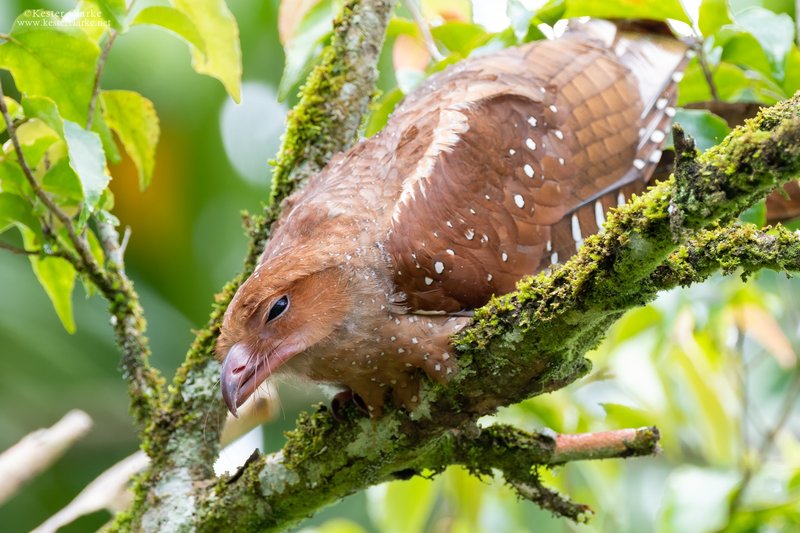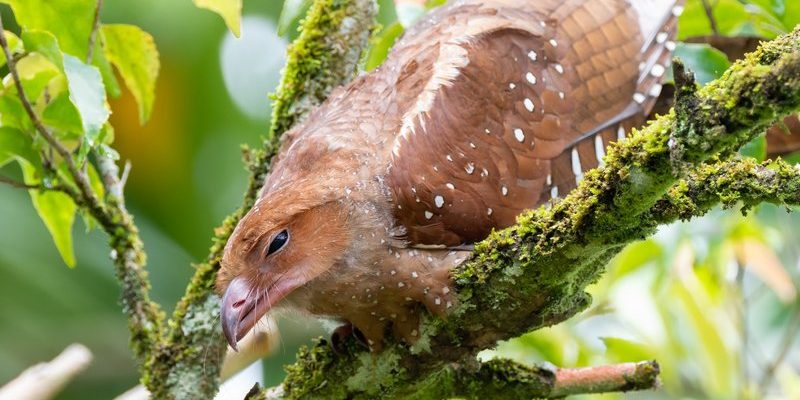
Have you ever heard of a bird that thrives in the dark like a bat? Meet the Oilbird, an extraordinary nocturnal bird that captivates both birdwatchers and nature enthusiasts alike. These fascinating creatures don’t just fly at night; they have an amazing set of adaptations that allow them to navigate and hunt in complete darkness, making them one of the few truly nocturnal birds in the world.
What’s more intriguing about the Oilbird is its diet. Unlike many birds that feast on seeds, insects, or small animals, Oilbirds are fruit specialists, primarily munching on the fleshy fruits of the oily palm trees. It’s like they have their very own gourmet restaurant in the forest! If you’re curious about how these unique birds live, where they come from, and what makes them so special, read on as we delve deeper into their world.
Physical Characteristics of the Oilbird
Size and Appearance
Oilbirds are medium-sized birds, usually measuring about 18 to 20 inches in length. Their wings are long and broad, which helps them glide silently through the night sky. One of the most striking features of the Oilbird is its rich brown plumage, which is intricately patterned with dark spots. This coloration not only offers beautiful aesthetics but also provides excellent camouflage among the branches of trees they frequent.
Another interesting aspect of their appearance is their large, expressive eyes. These eyes are proportionally bigger than what you’d find in many diurnal birds, allowing them to take in more light—a crucial feature for night navigation. The eyes of the Oilbird have a reflective layer, similar to that of cats, enabling them to see effectively in low-light conditions. It’s like having built-in night vision!
Distinctive Features
Aside from their appearance, Oilbirds possess some unique adaptations that aid in their nocturnal lifestyle. They have a highly developed sense of smell, which is unusual for birds. This exceptional olfactory ability helps them sniff out ripe fruits from a distance, guiding them to their favorite food source. Imagine having the ability to detect a delicious meal even when it’s hidden away!
Additionally, their wings are specially designed for silent flight. The leading edges of their feathers have soft, comb-like serrations that help reduce turbulence. This allows the Oilbird to glide gracefully and quietly, an important trait when avoiding predators and sneaking up on their fruity snacks.
Habitat and Distribution
Where Do Oilbirds Live?
Oilbirds primarily inhabit tropical rainforests, often found in mountainous regions of South America and parts of the Caribbean. They particularly favor areas with abundant fruit trees, which are essential for their survival. You might encounter them in places like the Andean foothills or the lush rainforests of Venezuela and Ecuador, where they roost in dark, cool caves during the day.
Interestingly, their choice of home isn’t just arbitrary. The caves provide a safe haven from predators while also being close to food sources. Imagine living in a cozy hideaway that also happens to be a buffet—sounds pretty ideal, right?
Global Distribution
While the Oilbird can be spotted in various regions, they have a rather limited global distribution. They are most commonly found in the northern parts of South America, with scattered populations extending into Central America and even parts of Trinidad and Tobago. Their preference for specific habitats means they might not be easy to spot, but that only adds to the allure for birdwatchers and nature lovers on the lookout for these elusive creatures.
Diet and Feeding Habits
What Do Oilbirds Eat?
As mentioned earlier, the Oilbird’s diet consists mainly of fruit. They are particularly fond of the fruits from the oily palm trees, which provide high-energy nourishment necessary for their active lifestyle. These birds have a specialized digestive system that helps them process tough fruits, ensuring they get every bit of goodness from their meals.
During their nightly foraging expeditions, Oilbirds will fly at various heights, scanning the forest floor and canopy for ripe fruit. It’s remarkable how they can cover large areas, locating food without the aid of sight, relying instead on their acute sense of smell. Imagine walking through a dark forest and knowing exactly where to find your favorite fruit just by sniffing it out!
Feeding Behavior
Oilbirds typically feed in flocks, which adds a social aspect to their nighttime activities. This group dynamic can help them locate food sources more effectively, and there’s safety in numbers as they explore the dark. They often return to the same fruiting trees night after night, establishing a routine that benefits them and aids in food sustainability.
Reproduction and Lifespan
Breeding Habits
The breeding season for Oilbirds varies depending on the region, but it generally occurs when food is abundant. After a courtship period, which involves calling and display behaviors, the female Oilbird will lay two to three eggs in a nest located deep within a cave or crevice. These nests are typically made from leaves and other vegetation, providing a safe spot for the young to grow.
Once hatched, both parents share in the responsibility of feeding the chicks, bringing them fruits on a regular basis. The young Oilbirds are born blind and helpless, relying entirely on their parents for survival during the initial weeks. As they grow, they gradually develop the strong flying skills needed to leave the nest.
Lifespan
In the wild, Oilbirds can live for several years, with a lifespan often exceeding ten years. However, factors such as predation and environmental changes can affect their longevity. For example, habitat destruction can pose serious threats, impacting their access to food and safe nesting sites. It’s a reminder of how interconnected nature is, and the challenges that creatures like the Oilbird face in an ever-changing world.
Conservation Status
Threats Facing Oilbirds
The Oilbird is currently listed as a species of least concern by the IUCN, thanks to its relatively stable populations in some areas. However, this doesn’t mean they are free from threats. Deforestation and habitat loss due to agriculture and urban development pose significant challenges. As their natural habitats shrink, Oilbirds struggle to find suitable nesting sites and food sources.
Additionally, human interference in certain regions can disrupt their breeding habits. For example, cave-dwelling species are particularly vulnerable to disturbances from tourism, which can lead to stress and abandonment of nests. Understanding these challenges is crucial for the conservation of the Oilbird, ensuring future generations can enjoy watching these unique birds.
Conservation Efforts
Various organizations are working to protect the habitats of Oilbirds and promote conservation awareness. Initiatives that focus on sustainable land use and reforestation are essential for keeping their populations stable. Moreover, educating local communities about the significance of preserving these birds can contribute to their overall well-being.
The Oilbird is truly a remarkable bird, uniquely adapted to life in the dark and filled with fascinating traits. From their incredible senses to their unique feeding habits, they remind us of the wonders of nature and the importance of conservation. As we explore the forests and caves where these birds thrive, let’s do our part to ensure they continue to soar through the night skies for generations to come.
FAQ
Are Oilbirds related to any other bird species?
Yes, Oilbirds belong to the family Steatornithidae, which is distinct from other birds. They share a common ancestor with nightjars and other nocturnal birds, adapting unique features that allow them to thrive in low-light environments. This familial connection highlights the diverse adaptations within the avian world.
Do Oilbirds migrate?
Oilbirds are generally not migratory. They tend to stay in their preferred habitats year-round, as long as food sources remain plentiful. However, local movements can occur based on changes in fruit availability, particularly during certain seasons when food is scarce.
Can you keep an Oilbird as a pet?
Keeping an Oilbird as a pet is not advisable. They are wild birds with specific habitat requirements and dietary needs that are challenging to replicate in captivity. Additionally, it’s important to respect wildlife and support conservation efforts rather than domesticate wild animals.
How can I spot an Oilbird in the wild?
Spotting an Oilbird in the wild requires some patience and knowledge of their habits. Focus on areas near fruiting trees in tropical rainforests during the evening hours when they are active. Listening for their distinctive calls can also lead you to them. Joining local birdwatching groups can enhance your chances of a successful sighting.
Are Oilbirds endangered?
Currently, Oilbirds are not considered endangered; they are classified as least concern. However, their populations could be at risk due to habitat destruction and other environmental threats. Conservation measures are crucial to maintaining their stability in the wild.
What do Oilbird chicks look like?
Oilbird chicks hatch covered in downy feathers and are initially blind and helpless. They rely heavily on the parents for food and protection. As they mature, they develop their distinct coloration and features, eventually becoming capable of flying and foraging for themselves.
How long do Oilbirds live?
Oilbirds can live for more than ten years in the wild, depending on factors like habitat stability and food availability. In captivity, they might live longer, though the challenges of captivity can affect their well-being.
What sounds do Oilbirds make?
Oilbirds are known for their distinctive calls that often resemble low, mournful sounds. These calls are typically heard at night and are part of their communication during mating and when establishing territory. The eerie sounds can be quite memorable!
Do Oilbirds have any natural predators?
Yes, Oilbirds face threats from various predators, including larger birds of prey and mammals. Their ability to nest in caves provides some protection, but they are still vulnerable, especially when flying about at night. This makes their stealthy flight and nocturnal habits crucial for survival.
What is the significance of the Oilbird in its ecosystem?
Oilbirds play a vital role in their ecosystems as seed dispersers. By consuming fruits and then excreting the seeds, they help promote the growth of new plants. This contributes to forest regeneration and maintains biodiversity in their habitats, highlighting their importance beyond just being fascinating birds.

